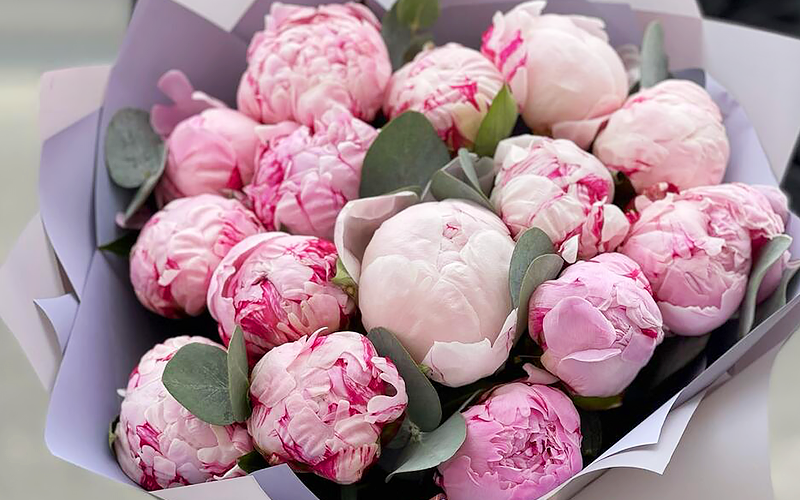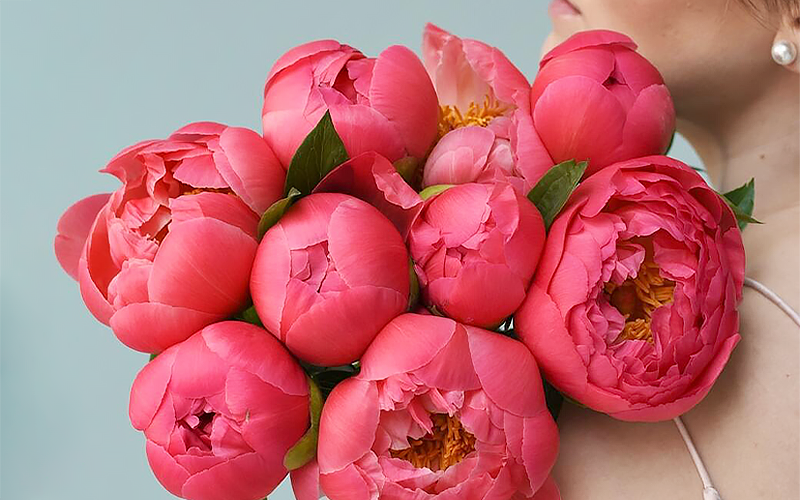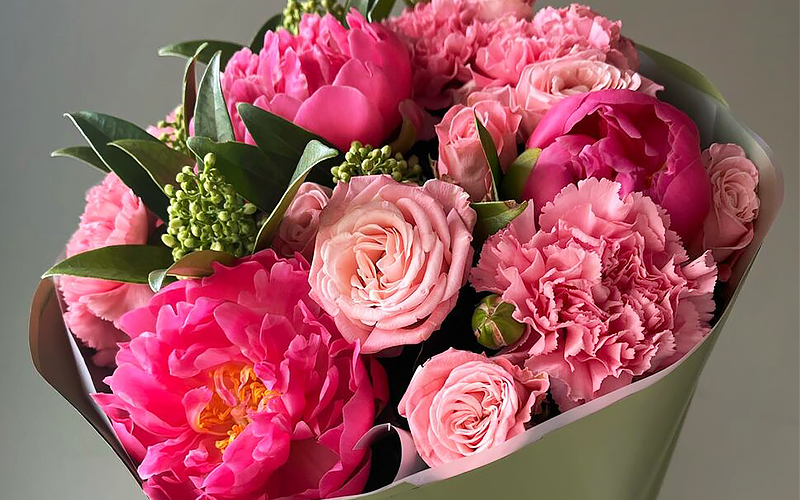If you’re planning to add these beauties to your garden, you ought to know the fascinating facts that, we are sure, will leave you stunned. Peonies are one of the most sought-after flowers in modern floristry. They are adored, admired, and even featured as a prime guest in romantic wedding ceremonies.
As Peonymania season in London is in full swing, the Flowwow team has conducted a small investigation and made a compelling conclusion: the love for peonies has endured for two thousand years – over that time, this flower has appeared in some of the most unexpected ways.
Monastery Garden Medicine
In the West, the peony has long been regarded not only as a beautiful flower but as a practical one. An extract, made from its roots and leaves, was used to treat epilepsy, headaches, asthma and as a general anticonvulsant and sedative. It’s no wonder that peonies have bloomed so lushly and abundantly for centuries in European monasteries.
Medieval alchemists held the peony in high esteem. They considered it to be a hemostatic, anticonvulsant, analgesic, bactericidal, and antitumor agent… a cure for all known illnesses. Indeed, it was the flower’s medicinal properties, not at all its beauty, that was so captivating for them.
To this day, peony extract (from the ‘evasive’ variety) is still actively used in medicine to soothe sleep disorders, anxiety, and vegetative-vascular disorders.
One of the Symbols of China
Peonies, the favourites of Chinese emperors, were first mentioned in written records dating back to the 2nd century AD. Silk embroidery, porcelain, and traditional yu-sin painting all depict these luscious blooms. However, in Chinese culture, the tree peony is the one valued the most, rather than the semi-double or full-double varieties commonly known to the European eye.
Today, peonies are one of the official symbols of China, along with the blossoming sakura. The city of Luoyang, China, rightly claims the title of the peony capital, where a grand festival has been held since 1982 annually from mid-April to mid-May.
The festival programme boasts bright exhibitions – a feast for the eyes and the senses, scientific conferences, and enchanting peony calligraphy master classes.
‘Prometheus Fire’ of Medicine
Legend has it that the peony was named after the Thracian region of Paeonia. According to another legend, rather beautiful, after the god-physician Paean, whose name derived from the Greek word “paionis,” meaning “healing.” The ancient demigod Paean was renowned as the physician of all the gods. In Homer’s Iliad, he tended to the wounds of Aida, Ares, and many celebrated heroes of the Trojan War.
Medicines fit for the gods were said to be far superior to those of mortals. With great compassion for humanity, Paean brought them a flower from Olympus that possessed miraculous properties – much like how Prometheus bequeathed fire to mankind. Alas, the gods’ reaction to such an act of generosity of their physician remains a mystery to us.
The Masculine Flower Women Adore
In Eastern culture, the peony symbolises masculinity more than femininity. Japanese samurais have even compared their battle armour to this flower – bright and richly decorated. Why dress up for combat like it’s a festival, you ask? It’s simple – in Japanese culture, being invisible in battle is the same as being a coward.
A duel among samurais is a spectacular art and an occasion to earn true glory. In Japan, they say: ‘In battle, look for a big flower’. In other words, aspire for glory and bravely move forward.
In China, a peony symbolises wealth, prosperity, and public recognition. So, giving a peony is like wishing your loved ones a life of abundance and success.
A Garden Dandy Tended With the Kid Gloves
In their boundless admiration, Chinese emperors went to great lengths. Peonies were no exception – for a long time, the imperial court employed a peony watcher. A young and dutiful lady tasked with using a special rabbit brush to cleanse the luxurious, flowering peonies of any speck of dust.
Notedly, for some time, the ordinary people of China were forbidden from cultivating peonies – only the nobles and dignitaries could indulge in the beauty of these flowers in their gardens.
A Model for All Time
Peonies can be found in dozens of famous paintings; their beauty is truly captivating. Modern Polish artist Zbigniew Kopania is simply obsessed with peonies, having already created dozens of juicy, lush still lifes featuring white-pink peonies.
A Flower with Edible Petals
Peonies are of medicinal use but are also a delightful treat! Their petals create a delectable jam akin to rose jam but lighter with a hint of spice. Dried peony petals can be brewed into tea – though, unlike extracts from the roots and leaves, more of a tonic.
And if you’re feeling bold and adventurous, create an exquisite pink wine by blending 3-4 varieties of peonies- white, pink, burgundy- with a mixture of sugar and citric acid. Let it brew for a month and a half, and indulge in a flavourful sip.
Sensual Bliss
Peonies are a wonder for the skin and are widely used in cosmetology! Peonies are a wonder for the skin and a delight for the senses! They star in luxurious baths, where 5-6 fully bloomed buds are steeped in boiling water, infused, strained and added to the bath.
These delicate blooms also feature face masks and lotions. Dried petals are soaked in olive oil for several weeks to make nourishing and glowing skin products.
Beloved by Artistic Souls
Peonies have long been the muses of artistic souls, drawing them with their abundant beauty and irresistible charm. One of the most popular peony varieties – ‘Sarah Bernhardt’ – was named after the greatest actress of modern times. This variety was created in 1905 by the French breeder Pierre Louis Victor Lemoine.
History is silent about the relationship between Lemione and the great actress – they probably didn’t even know each other. Yet, it’s likely that he named his peonies after her – remembering the wild, unruly curls of the actress. The ‘Sarah Bernhardt’ peony variety is just as lush and slightly messy, mirroring her iconic untamed locks.
Many gorgeous ladies have spoken of love to Peony. Catherine Deneuve is known to lose herself for hours amidst bushes of white peonies enchanted by their delicate petals. Liv Tyler has pledged her undying love for the peony. And Drew Barrymore chose a lavish bouquet of ‘Kansas’ and ‘Sarah Bernhardt’ peonies for her wedding.
A Source of Passion
Peonies are the perfect flowers to kindle passion and romance, especially on a date. They have a harmonising effect that helps you relax and unwind. Also, their captivating scent acts as a natural aphrodisiac for both men and women.
The 12th wedding anniversary is known as the peony anniversary – nothing could be more appropriate than giving your beloved one a bouquet of these prominent flowers on your memorable day.
The peony season in the UK lasts until mid-June, and this is the best time to surprise your loved ones with a gorgeous bouquet of peonies. These exquisite blooms are available for all kinds of uses, especially during the peak season.
About Flowwow:
Flowwow is a Hungarian-based startup that is currently expanding its services in UK, European markets, the Middle East and North Africa (MENA) region collaborating with local businesses and providing them with platforms and tools to flourish and gain loyal customers. Customers can enjoy the joy of gifting from an array of items like flowers, cakes, jewellery, and cosmetics using the Flowwow mobile app or the desktop site. The brand aims to simplify and enhance the joy of gifting through services like speedy-same day deliveries, product photos before the delivery and curated product lists from various local businesses. You can surprise your loved ones from any part of the world as Flowwow is a home to 11000+ local brands from 1000+ cities
Written by Albina Arndt, head of partnership at Flowwow
*Partner content*




